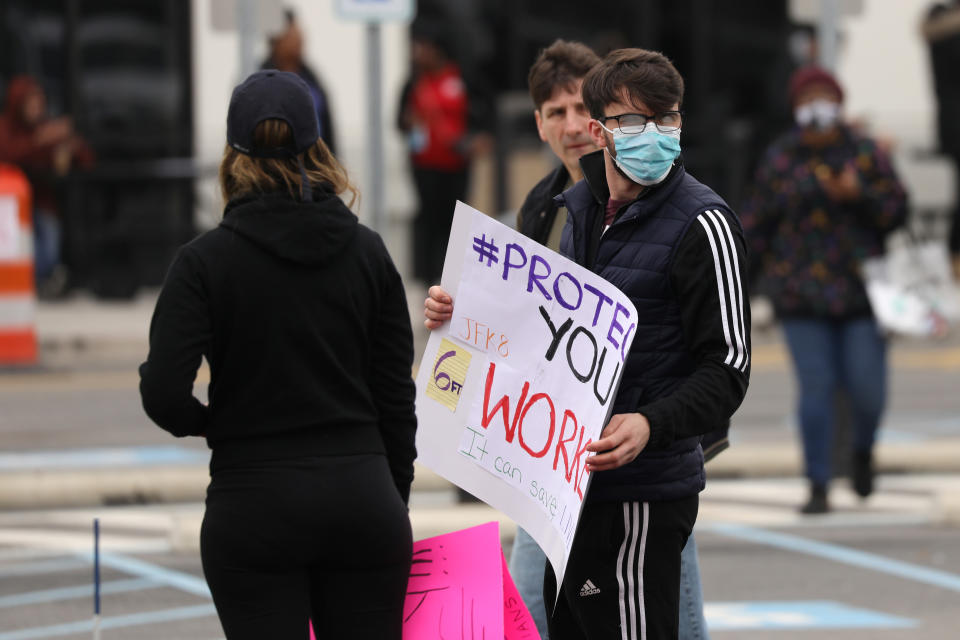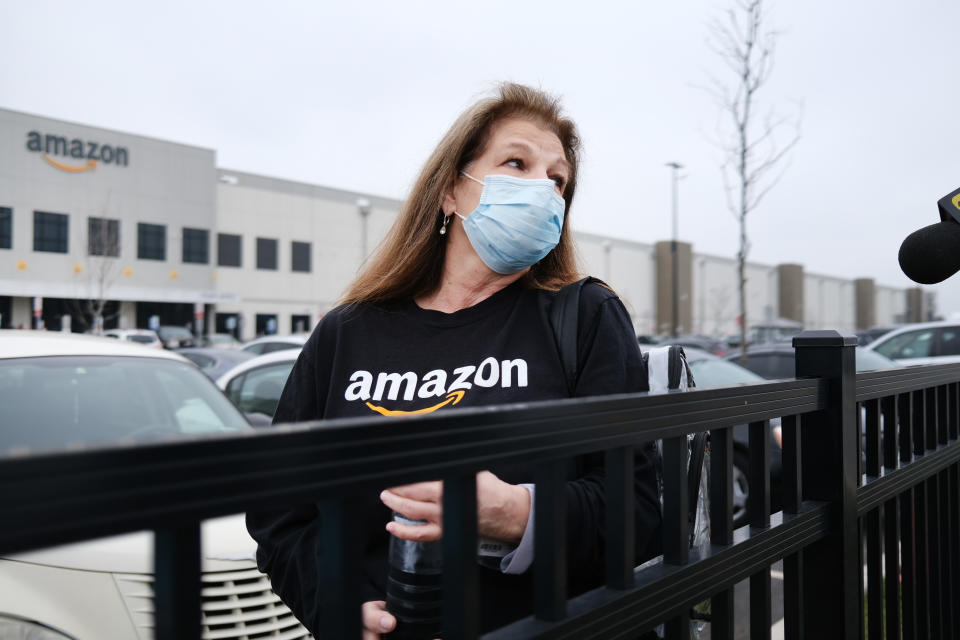'We can do better': Amazon warehouse workers stage largest protest since coronavirus outbreak
A movement of Amazon warehouse workers fearful of coronavirus exposure escalated its confrontation on Tuesday over what they consider insufficient safety measures, as workers launched a protest that will involve about 350 employees refusing to work in more than 50 warehouses in the coming days, organizers said.
The novel coronavirus has hiked demand for Amazon’s (AMZN) delivery service as hundreds of millions of Americans are forced into their homes. But the global pandemic has also prompted fear and frustration among many of the company’s warehouse workers, who have staged a series of protests nationwide accusing the company of inadequate safety measures and insufficient paid leave as more Amazon warehouses have reported infections. Amazon has strongly disputed the claims.
The walkout on Tuesday kicks off the largest Amazon worker protest since the coronavirus outbreak, expanding the movement from scores of workers at a handful of warehouses to hundreds spread across dozens of facilities in about 20 states, according to organizers. Workers called on the company to provide paid leave for workers to stay home if necessary, as well as temporarily close warehouses that have failed to address the safety risks.
‘We can do better’
Rachel Belz, 32, a warehouse worker at a New Jersey-based Amazon facility where she said at least 12 workers have tested positive for coronavirus, has been on unpaid leave since March 13 because she fears contracting the virus and spreading it to her young son or her parents, one of whom is immunocompromised and the other has a severe lung condition.
“I would never forgive myself if I were the reason that either of them or my son were to contract anything, let alone this virus,” she says. “Money is a renewable resource — they’re not.”
She says she can last without pay for “possibly another month,” relying on a recent tax refund as well as her coronavirus stimulus check.

About a dozen other workers at her facility signed a pledge to join her in the protest on Tuesday, she said, adding that more would have participated if not for fear of retaliation.
“It just takes a spark to start a fire,” she says. “I’m not looking to burn the whole system down — just think we can do better.”
‘A man-made disaster’
The protest is “a big deal in conveying how desperate workers are to exercise some power over this calamity that’s descending upon them,” says Sharon Block, a lecturer on labor at Harvard University Law School and a former head of the Policy Office at the U.S. Department of Labor under the Obama Administration.
“The system is set up for workers to fail unless they do desperate things like walk off their jobs in the middle of this terrible crisis,” she says, citing challenges that face workers trying to win safety protections from large companies like Amazon.
For its part, Amazon accused protest organizers of overstating the number of participating workers and rebutted worker criticism, citing the company’s efforts to take the temperature of workers before they enter U.S. facilities, provide all workers with protective masks, and give partial pay to workers who are sent home with a fever.
“Reports of employee participation in today’s event organized by labor unions are grossly exaggerated,” says Amazon spokesperson Lisa Levandowski.
“Already today more than 250,000 people have come to work today, even more than last week to serve their communities,” she adds. “We couldn’t be more grateful and proud for their efforts during this time. The union organizers claims are also simply false – what’s true is that masks, temperature checks, hand sanitizer, increased time off, increased pay, and more are standard across our network because we care deeply about the health and safety of our employees.”
The actions undertaken by Amazon employees are among a host of work stoppages by workers across the economy, including a nationwide “Sick Out” at Amazon-owned Whole Foods grocery stores and an Instacart strike. Meanwhile, tens of millions of Americans have lost their jobs in recent weeks, suddenly erasing nearly all of the jobs created since the Great Recession.
“The virus is a natural disaster, but these economic consequences to a large extent are a man-made disaster,” Block, the former labor official with the Obama administration, says. “The result of a tattered social safety net, the result of laws that don’t allow workers to engage in collective action.”
“Can’t fix a natural disaster part but you can fix the man-made disaster part,” she adds.
‘No effect on the production’
The growing Amazon worker movement may not be large enough to win major concessions from the company, however, leading logistics experts told Yahoo Finance. The worker participation remains a small fraction of the hundreds of thousands of warehouse employees at the company nationwide, they said.
“I don’t think the 300 people is a very big number,” says Dale Rogers, a professor of logistics and supply chain management at Arizona State University. “If all of a sudden 3,000 people or 30,000 people were walking out of Amazon warehouses, I think that would be significant.”
Yossi Sheffi, a professor at the MIT Center for Transportation and Logistics, said the current size of the protests will not disrupt Amazon operations even amid the spike in demand.

“That will have no effect on the production,” he says.
On March 31, workers at a Staten Island warehouse held an initial protest over infection fears, and the dispute deepened when later that day the company fired one of the participating workers, Chris Smalls, for allegedly violating social distancing guidelines. Smalls, union leaders, New York’s attorney general, and elected officials like Democratic New York Rep. Alexandria Ocasio-Cortez have publicly criticized the company’s conduct toward him. A second protest was held at the facility one week later.
The company has more than 110 fulfillment centers in North America, according to its website. The warehouse in Staten Island is one of the company’s largest urban facilities, the Verge reported last year. The facility is 855,000 square feet and has 4,500 workers.
Jordan Flowers, 21, a warehouse worker at the Staten Island facility, has not gone in for a shift since Feb. 28 out of fear of contracting the virus. But he has helped organize the worker actions at the site, including the protest on Tuesday.
“It’s momentum,” he says. “We’re a bunch of workers with similarities and we want to take a stand.”
Read more:
'We're risking our lives': Why Amazon warehouse workers are walking out over coronavirus fears
Top unions call for closure of all Amazon warehouses — experts say it would be disastrous
Workers condemn coronavirus relief bill's loophole for big companies
Read the latest financial and business news from Yahoo Finance
